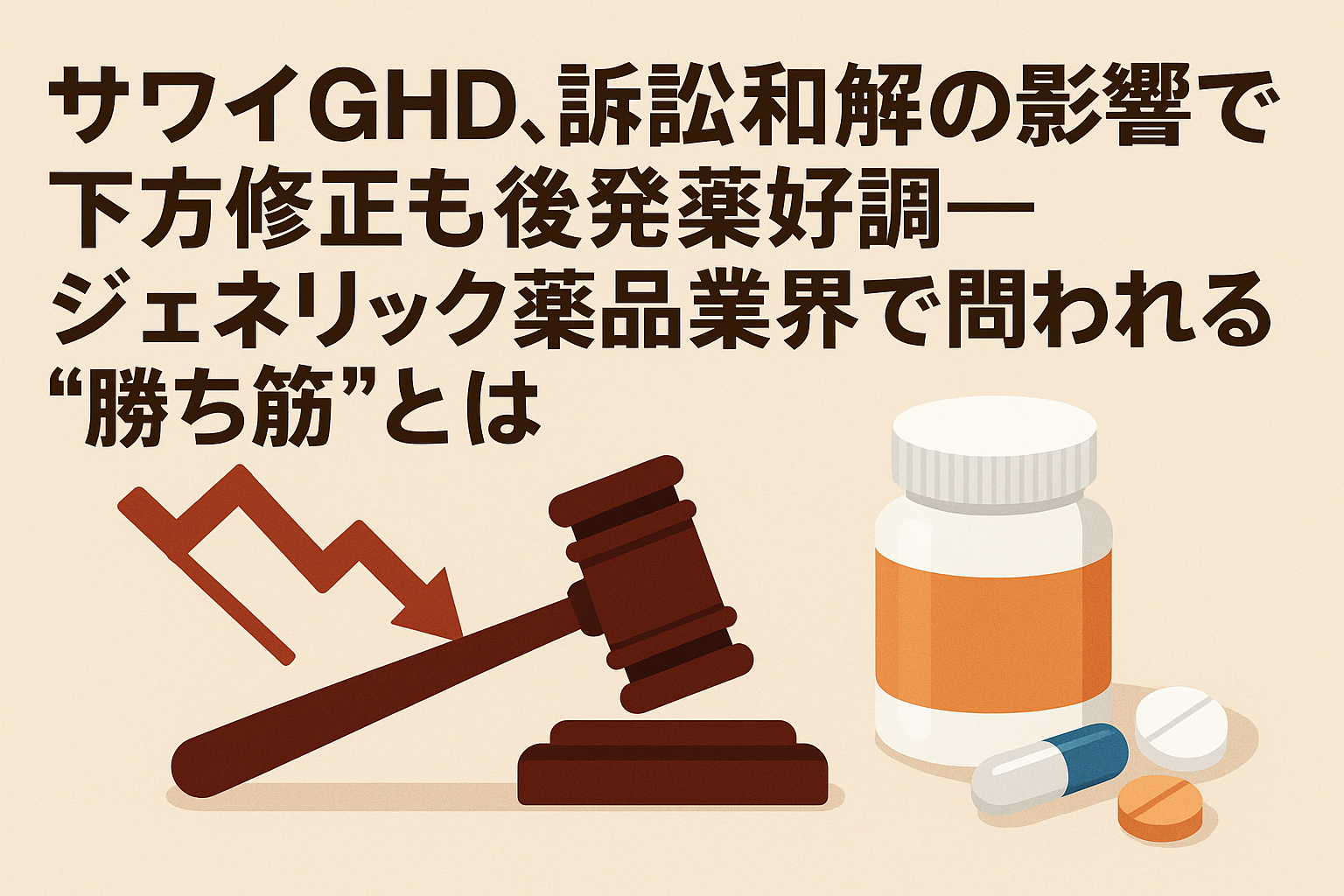Sawai Group Holdings (Sawai GHD) announced that its consolidated net profit for the fiscal year ending March 2026 is projected to rise 17% year-on-year to 14 billion yen. However, this represents a downward revision of 3.4 billion yen from the previous forecast of 17.4 billion yen.
The revision stems from the booking of roughly 4 billion yen as a “provision for litigation loss” following a settlement with Asahi Kasei Pharma, which had sued Sawai Pharmaceutical (a Sawai GHD subsidiary) for patent infringement regarding the manufacturing process of its generic osteoporosis drug.
Meanwhile, sales revenue (equivalent to net sales) is expected to rise 7% to 202.5 billion yen, reflecting strong generic drug sales.
Thus, the situation is mixed: profits are suppressed due to litigation-related costs, but the company’s core generic business continues to expand.
This article examines the news from three perspectives: (1) litigation risk management, (2) growth potential of the generic drug market, and (3) Sawai GHD’s strategic direction.
The Cost of Settlement and Its Implications
The first key point is the 4 billion yen charge from the lawsuit settlement.
Asahi Kasei Pharma sued Sawai Pharmaceutical, alleging patent infringement related to the manufacturing process of a generic osteoporosis drug.
The two companies reportedly reached a settlement under which Sawai agreed not to manufacture or sell the product while the patent remains valid.
As a result, Sawai GHD eliminated litigation risk but relinquished revenue from the affected product line for the time being.
The provision for litigation loss (4 billion yen) directly caused the downward profit revision.
Key takeaways from this sequence of events include:
- Visualization and Early Resolution of Patent Risk
By opting for settlement rather than prolonging litigation, Sawai demonstrated a proactive stance in managing risk — addressing it early instead of leaving it unresolved. For investors and stakeholders, this signals sound risk governance: converting potential uncertainty into quantifiable impact.
- Partial Loss of Revenue Opportunities
However, the settlement’s condition — halting production and sales during the patent’s validity — means lost revenue for Sawai Pharmaceutical. Given that generics are a core business for Sawai GHD, the significance of the affected product’s contribution to sales and profit bears watching. Even if it was a mid-range product, withdrawing it could affect long-term revenue stability.
- Reinforcing IP Strategy and Manufacturing/Sales Framework
This experience likely heightens Sawai GHD’s awareness of the need for more sophisticated IP strategies, including patent searches, manufacturing process risk assessment, and timing of market entry. It also underscores the importance of having substitute products or new launch plans ready if certain items must be temporarily withdrawn.
Favorable Market Winds and Sawai GHD’s Position
Next, let’s consider the macro environment of the generic drug market and Sawai GHD’s standing.
- Market Tailwinds
As Japan’s population ages, demand for prescription drugs and total medical costs continue to rise. Generics are being promoted as a national policy measure for cost reduction and medical expense optimization.
According to industry data, generics now account for over 50% of prescription volume, reinforcing the perception of the sector as a stable-growth market.
Sawai GHD has indicated its intention to evolve “beyond generics” into a broader healthcare group, with initiatives extending into digital medical devices and health management apps.
- Strengths and Challenges
Strengths: Sawai has decades of experience and a strong presence in Japan’s generic drug market. At investor briefings, the company has emphasized its nationwide reach—selling about 16 billion tablets annually, or roughly one tablet for every Japanese person every three days—illustrating its infrastructure-level role.
Challenges: Rising manufacturing costs and the increasing complexity of products (e.g., biologics) are changing the playing field. Competing solely on low price is no longer sufficient.
Moreover, industry-wide issues such as intensifying competition, price pressure, and supply instability (drug shortages) have become prominent concerns.
- Strong Sales but Deferred Profit
For FY 2026, Sawai GHD expects sales revenue to increase 7% to 202.5 billion yen, reflecting about 2.3 billion yen of upside from robust generics sales.
However, operating and net profit forecasts were revised downward due to litigation costs — meaning sales growth is being offset by deferred profit recognition.
Strategic Outlook: Rethinking Growth and Profit Models
To ensure sustainable growth and profitability, Sawai GHD must focus on the following:
- Rebuilding the Product Portfolio
The suspension of manufacturing and sales for certain items should prompt a re-evaluation of portfolio management — deciding which products to prioritize or phase out, while weighing patent risk, technology transfer risk, and price competition.
- Strengthening IP Risk Management and Legal Strategy
The recent lawsuit exemplifies a typical risk for generics manufacturers. Sawai GHD’s long-term stability will depend on reinforcing patent clearance procedures, securing originality in manufacturing technologies, and rationally setting provisions for potential litigation costs.
- Shifting Away from Volume-Dependent Profit Models
The traditional “volume-driven” generics model is under pressure from rising costs, falling prices, and fierce competition. Sawai’s move into non-generic businesses such as digital health and wellness apps reflects a shift toward a “volume + value” model for profit enhancement.
- Ensuring Supply Stability and Production Capacity
Amid ongoing reports of generic drug shortages, Sawai GHD is emphasizing expanded production capacity and stricter quality control.
Stable supply directly supports market share and brand trust, especially in periods of price decline.
At first glance, this news seems negative — a downward revision in net profit. Yet, behind it lies a forward-looking move: addressing litigation risk proactively while continuing to expand generics sales.
The real question is whether Sawai GHD can turn this “painful structural adjustment” into a catalyst for transformation — building a value-added, stable earnings model beyond simple volume growth.
For readers, this episode offers insights into the current state of Japan’s pharmaceutical and generics industry, while highlighting key perspectives to watch in Sawai GHD’s ongoing evolution.

